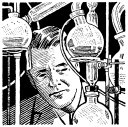

Alan S. Rojer has been privileged to work in a variety of technology settings for the last three decades, including knowledge engineering, model-driven development, language synthesis, digital media processing, financial analytics, regulatory arbitrage, computational neuroscience, and energy systems engineering. In all these settings, Rojer has been a prolific provider of original software.
Rojer founded Dimelab in 2001. He set out to provide software and other products to facilitate analysis, tranformation, and synthesis of digital media, especially on open-source platforms including Linux. This original media-oriented work evolved steadily in various directions, leading to significant results in in knowledge engineering, model-driven development, and language synthesis.
Rojer's interest in management of web bookmarks led through various implementations to a novel natural langauge classification system, for which US Patent 7,747,937 has been issued for a Web Bookmark Manager. The classifier automatically determines categories by analysis of the phrasal structure of descriptive text associated with bookmarks.
Most recently, Rojer has been working on the integration of syndication feeds with bookmark management. His key insight is that your bookmark catalog provides an excellent representation of your online interests; a bookmark catalog may thereby serve as an effective discriminator on syndication feeds, ranking feed entries according to their match against a bookmark catalog. This system for ranking feed entries according to their affinity to a bookmark catalog is patent pending. This capability is under active development as a web service and soon be deployed.
Building better software more quickly through models and code generation has been another of Rojer's interests. One of the early fruits of this effort is a patent pending for object-oriented processing of markup, which will soon issue as US Patent 7,844,956. Rojer also developed a high-level language for specification of object-oriented modules which has been documented in three pending patent applications:
Rojer has long had great enthusiasm for the design and implementation of special-purpose languages. A smooth integration of modern object-oriented technique with classic Unix parser tools may be found in his tool for parsing to object-oriented dispatch. Some shortcomings of XML are addressed by and US Patent 7,698,633 for Markup Metalanguage. Rojer has also created a versatile new general-purpose paradigm for integration of computation and representation which formalizes the subject-predicate nature of natural language for use in computational settings. Declarative dispatch as a computational technique is described by US Patent 7,454,429. Declarative discourse as a reprentational technique is patent pending.
Prior to founding Dimelab, Rojer spent about four years ON2 Technologies, formerly known as the Duck Corporation. Rojer spearheaded video compression research and development. Rojer provided the last generation of encoder for the TrueMotion product line. Rojer then headed an advanced R&D effort at Duck, leading a peak staff of five researchers. The advanced R&D effort concentrated on applications of computer graphics technology (especially subdivision meshes) to video encoding. Rojer also explored techniques and applications for motion compensation incorporating motion segmentation.
Before joining Duck, Rojer worked in several positions providing development of software for financial analytics. Rojer was employed variously by Bear Stearns, Sumitomo Bank Capital Markets, and Lehman Brothers. Rojer's work concentrated on portfolio financial analytics. He provided a variety of software tools to facilitate computation on heterogeneous portfolios, including
Prior to working on Wall Street, Rojer provided software for analysis of EEG data for a biomedical startup. Rojer also provided software for regulatory arbitrage for compliance with federal corporate average fleet efficiency (CAFE) regulation for a major domestic auto manufacturer, as well as software for for slicing and dicing consumer product purchase data for a market research data provider. Before returning to full-time Ph. D. study, Rojer was employed for three years by Stone and Webster Engineering Corp., since absorbed by The Shaw Group, Inc, where he performed engineering and financial computations related to energy systems engineering. Rojer also built, in the early 80's, a IBM-PC application to assist in selection of hearing aids.
Rojer attended Cornell University, earning in 1981 a B.A. in Biological Sciences from the College of Arts and Sciences, as well as a B.S. in Mechanical Engineering from the College of Engineering. Rojer was an enthusiastic student, accumulating over five years of undergraduate study well over 200 course credits, compared to the 120 credit requirement for a bachelor's degree. In addition to his earned majors, Rojer completed most of the required coursework for majors in Engineering Physics and Geology.
While employed full-time at Stone and Webster, Rojer earned a masters in computer science at Steven Institute of Technology (1983).
Rojer returned to full-time computer science study in 1984
at the Courant Institute for Mathematical Sciences
at New York University.
He was fortunate to study computational neuroscience
and machine vision
under
Eric L. Schwartz.
Rojer earned the Ph. D. in 1990;
his dissertation was titled
Space-variant computer vision with a complex-logarithmic sensor geometry
.
Rojer's work under Schwartz led to the publication
of about a dozen academic papers.
Rojer passed the US Patent Bar Examination in Spring, 2001, qualifying him to practice before the US PTO as a registered Agent. His registration number is 48,792. Rojer also qualified as an Engineer in Training (EIT) in New York in the early 80's. Rojer is a member of the ACM and the IEEE.
Rojer serves as a member of the board of directors of Auricle Corporation, a non-profit 501c corporation which supervises the operations of WFMU, the superlative free-form radio station.